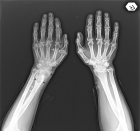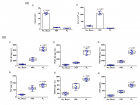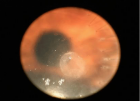Abstract
Research Article
Estimating minimum post-mortem interval in a Nigerian murder case using Chrysomya megacephala (Fabricius, 1794) (Diptera: Caliphoridae): The first use of forensic entomology
Ado-Baba Ahmed* and Godwin Iko Ayuba3
Published: 26 April, 2023 | Volume 7 - Issue 1 | Pages: 011-016
Introduction: This paper presents the first application of forensic entomology in a murder investigation in Nigeria involving the remains of a 54-years victim, on January 9th, 2019 in a shaded wooded area in advanced decomposition, with no clear indication of the time of death.
Objectives: To estimate the minimum post-mortem interval of a 54-year-old corpse recovered in the advanced decomposition stage using the blowfly Chrysomya megacephala and the Advance-Degree-day (ADD) method.
Results: An autopsy report revealed multiple wounds to the forehead including a bullet hole. Dead embalmed dead maggots recovered from the body were identified as C. megacephala, and an accumulated degree-day model was used to estimate the minimum post-mortem interval. The findings revealed that the recovered larvae were still within the third-instar stage and had accumulated thermal energy between 58 hours (= 1.6 days, equivalent to 38.7 ADD) and 102 hours (= 2.8 days, equivalent to 68.0 ADD), suggesting that the body may have been exposed to insect activity between January 1st and 9th January 2019 after expanding the range to cater for some uncertainties.
Conclusion: In this Nigerian murder case, forensic entomology used the calliphorid species C. megacephala to estimate the minPMI to be between 2 and 9 days before the body was discovered, which translates to 1st - 9th January 2019 after consideration of some uncertainties and limitations. This confirmed the crucial role that insects play in providing valuable evidence to complement forensic pathological findings in homicides when conventional methods failed. Notwithstanding difficulties with employing insect evidence in forensic investigations in Nigeria, the application of this modern forensic technique has the potential to aid in the resolution of many unsolved murder cases and expedite the delivery of justice. The ability of law enforcement agencies in Nigeria to use the potential of insects in criminal investigations can be improved through collaborations and training with professionals from diverse professions.
Read Full Article HTML DOI: 10.29328/journal.jfsr.1001044 Cite this Article Read Full Article PDF
Keywords:
Unsolved murder; Forensic entomology; Accumulated-degree-day; Minimum post-mortem interval; Nigeria
References
- Tomberlin JK, Byrd JH. Forensic Entomology: International Dimensions and Frontiers. 2020.
- Anderson GS. Forensic entomology: The use of insects in death investigations. 2022. https://www.sfu.ca/~ganderso/forensicentomology.htm#_ftn1
- Yan L, Pape T, Meusemann K, Kutty SN, Meier R, Bayless KM, Zhang D. Monophyletic blowflies revealed by phylogenomics. BMC Biol. 2021 Oct 27;19(1):230. doi: 10.1186/s12915-021-01156-4. PMID: 34706743; PMCID: PMC8555136.
- Hall MJ, Wall RL, Stevens JR. Traumatic Myiasis: A Neglected Disease in a Changing World. Annu Rev Entomol. 2016;61:159-76. doi: 10.1146/annurev-ento-010715-023655. Epub 2015 Dec 7. PMID: 26667275.
- Wallman JF, LeBlanc HN. Medicolegal Forensic Entomology. In J Amendt, J Goff, M. Grassberger (Eds.), Current Concepts in Forensic Entomology. 2019; 295-318. Springer Cham.
- Pechal JL, Benbow ME, Tomberlin JK. Microbial ecology of carrion decomposition. In C. M Tridico & SM Williams (Eds.), Forensic Ecology Handbook: From Crime Scene to Court. 2020; 91-115. John Wiley & Sons.
- Sherman RA, Wetherbee MM, Belant JL. Consequences of Chronic Wasting Disease and Conservation Implications for North American Carnivores. Integrative Zoology. 2021; 16(4):819-828.
- Kallweit N, Rust MK. Insecticidal activity of spinosad and indoxacarb against larvae of Phormia regina (Diptera: Calliphoridae). Journal of Medical Entomology. 2021; 58(4): 1534-1540.
- Pohjoismäki JL, Karhunen PJ, Goebeler S, Saukko P, Sääksjärvi IE. Forensic entomology cases in Finland: A review of past and present cases. Forensic Sci Int. 2019; 297:259-267. doi: 10.1016/j.forsciint.2019.02.003. Epub 2019 Feb 7. PMID: 30802694.
- Singh D, Gurjar G, Sahni V, Garg R, Athawale V, Singh M, Singh D, Dohare R. Forensic entomology: An extensive review. Forensic Sci Int. 2020; 313:110334. doi: 10.1016/j.forsciint.2020.110334. Epub 2020 May 23. PMID: 32505854.
- Tarone AM, Crippen TL, Benbow ME. The Use of Calliphorid Flies in Forensic Investigations. In Carrion Ecology and Management. 2020; 149-165.
- Wells JD, LaMotte LR. Forensic Entomology. In StatPearls. 2021.
- Ewuim SC, Abajue MC. Forensic entomology: the journey so far in Nigeria. Open Sci. J. Biosci. Bioeng. 2016; 3(1):1-4.
- Onyishi GC, Osuala F, Aguzie IO, Okwuonu ES, Orakwelu CH. Arthropod succession on exposed and shaded mammalian carcasses in Nsukka, Nigeria. Animal Research International. 2020; 17(3):3869–3877.
- Akinkuolie TA, Kudirat AO. A review of forensic entomology in Nigeria: prospects and challenges. Journal of Forensic Sciences & Criminal Investigation. 2021; 18(3):555972.
- Sontigun N, Sukontason KL, Amendt J. Embalmed maggots (Diptera: Calliphoridae) in forensic entomology. Journal of Forensic Sciences. 2021; 66(1): 90-94.
- 2021. https://www.nhm.ac.uk/research-curation/scientific-resources/taxonomy-systematics/myiasis-larvae/specimen-collection-guide/index.html.
- Zaidi F, Zaidi S, Husain A. Forensic Entomology: Review of Various Aspects. Journal of Forensic Research and Analysis. 2021; 2(1):13-20.
- Wells JD, LaMotte LR, Sontigun N, Tarone AM. The value of calliphorid flies and their larvae in forensic entomology. Insects. 2021; 12(1):58. https://doi.org/10.3390/insects12010058
- Erzinclioglu YZ. The larvae of two closely-related blowfly species of the genus Chrysomya (Diptera, Calliphoridae). Entomologica Fennica. 3.XII. 1990.
- Sukontason K, Piangjai S, Siriwattanarungsee S, Sukontason KL. Morphology and developmental rate of blowflies Chrysomya megacephala and Chrysomya rufifacies in Thailand: application in forensic entomology. Parasitol Res. 2008 May;102(6):1207-16. doi: 10.1007/s00436-008-0895-6. Epub 2008 Feb 10. PMID: 18264799.
- Hofer IMJ, Hart AJ, Martín-Vega D, Hall MJR. Estimating crime scene temperatures from nearby meteorological station data. Forensic Sci Int. 2020 Jan;306:110028. doi: 10.1016/j.forsciint.2019.110028. Epub 2019 Oct 30. PMID: 31791700.
- Gennard D. Forensic Entomology: An Introduction. Wiley. Chichester. 2007; 224 ISBN: 9780470014783:240.
- Prins AJ. Morphological and Biological Note on Six South African Blowflies (Diptera, Calliphoridae) and Their Immature Stages. Ann. S. Afri. Mus. 1982; 90 (4):201-217.
- De Donno A, Di Vella G, Santoro V, Introna F. Factors affecting postmortem interval estimation. Journal of Forensic Sciences. 2019; 64(5):1368-1373. doi: 10.1111/1556-4029.14058.
- Badenhorst R, Villet MH. The uses of Chrysomya megacephala (Fabricius, 1794) (Diptera: Calliphoridae) in forensic entomology. Forensic Sci Res. 2018 Mar 21;3(1):2-15. doi: 10.1080/20961790.2018.1426136. PMID: 30483647; PMCID: PMC6197084.
- Mostafa G, Shahanaz S. Estimation of accumulated degree hours-based post-mortem intervals in mammalian and avian model. Jahangirnagar University J. Biol. Sci. 2020; 9(1 & 2): 49-58.
- Matuszewski S. Post-Mortem Interval Estimation Based on Insect Evidence: Current Challenges. Insects. 2021 Apr 1;12(4):314. doi: 10.3390/insects12040314. PMID: 33915957; PMCID: PMC8066566.
- Campobasso CP, Introna F, Magni PA. Forensic entomology: application, utility and limitation in criminal investigations. Journal of forensic and legal medicine. 2014; 26:14-24.
- Smith KGV, Wells JD, Merritt RW, Tomberlin JK. Necrophagous insects on vertebrate remains in Texas: diversity, phenology, and decomposition ecology. Environmental Entomology. 2020; 49(2):368-379.
- Oluwatosin OM, Onwordi CT. The Challenges of Forensic Science in Nigeria. Journal of Forensic Sciences & Criminal Investigation. 2019; 11(1):555802. doi: 10.19080/jfsci.2019.11.555802
- Esimai OA, Esan OT. Overview of forensic science in Nigeria: trends, challenges and prospects. Journal of Forensic Science & Criminology. 2020; 8(1):555725. doi: 10.19080/JFSCJ.2020.08.555725
- Lutz L, Verhoff MA, Amendt J. To Be There or Not to Be There, That Is the Question-On the Problem of Delayed Sampling of Entomological Evidence. Insects. 2021 Feb 9;12(2):148. doi: 10.3390/insects12020148. PMID: 33572161; PMCID: PMC7915408.
- Hall MJR. The Relationship between Research and Casework in Forensic Entomology. Insects. 2021; 12: https://doi.org/10.3390/insects12020174
Figures:
Similar Articles
-
Enclosure asphyxia as a cause of death in 3 Nigerian children trapped at the boot of car-Case reports and review of literatureMartin A Nzegwu*,FMCPath Nig,DB Olusina Francis Ikechukwu Ukekwe,Victor Nzegwu. Enclosure asphyxia as a cause of death in 3 Nigerian children trapped at the boot of car-Case reports and review of literature. . 2017 doi: 10.29328/journal.jfsr.1001010; 1: 087-091
-
Awareness level on the role of forensic DNA database in criminal investigation in Nigeria: A case study of Benin cityNwawuba Stanley Udogadi*,Akpata Chinyere Blessing Nkiruka . Awareness level on the role of forensic DNA database in criminal investigation in Nigeria: A case study of Benin city. . 2020 doi: 10.29328/journal.jfsr.1001019; 4: 007-014
-
Awareness level on the relevance of forensics in criminal investigation in NigeriaOmorogbe Owen Stephen,Orhue Osazee Kelvin,Ehikhamenor Edeaghe,Nwawuba Stanley Udogadi*. Awareness level on the relevance of forensics in criminal investigation in Nigeria. . 2021 doi: 10.29328/journal.jfsr.1001028; 5: 053-057
-
A study on the determination of sex using lip print patterns among indigenes of Akwa Ibom State, NigeriaObosi NJ*,Akpantah AO,Archibong VB,Duru GO. A study on the determination of sex using lip print patterns among indigenes of Akwa Ibom State, Nigeria. . 2022 doi: 10.29328/journal.jfsr.1001032; 6: 017-023
-
Alcohol drinking and driving habit particularly in Nigeria and the role forensic science could playMaurice E Nwakobi*. Alcohol drinking and driving habit particularly in Nigeria and the role forensic science could play. . 2022 doi: 10.29328/journal.jfsr.1001038; 6: 068-076
-
Estimating minimum post-mortem interval in a Nigerian murder case using Chrysomya megacephala (Fabricius, 1794) (Diptera: Caliphoridae): The first use of forensic entomologyAdo-Baba Ahmed*, Godwin Iko Ayuba3. Estimating minimum post-mortem interval in a Nigerian murder case using Chrysomya megacephala (Fabricius, 1794) (Diptera: Caliphoridae): The first use of forensic entomology. . 2023 doi: 10.29328/journal.jfsr.1001044; 7: 011-016
-
Male Linear Anthropometrics of Selected Nigerian Ethnicities: A Cross - Sectional AnalysisMichael Okon*, HB Fawehinmi, LE Oghenemavwe, PD Okoh, LK David, CA Oparaocha, CE Ebieto, TA James, AN Maryam, TK Adenowo. Male Linear Anthropometrics of Selected Nigerian Ethnicities: A Cross - Sectional Analysis. . 2024 doi: 10.29328/journal.jfsr.1001066; 8: 064-070
Recently Viewed
-
Prediction of neonatal and maternal index based on development and population indicators: a global ecological studySedigheh Abdollahpour,Hamid Heidarian Miri,Talat Khadivzadeh*. Prediction of neonatal and maternal index based on development and population indicators: a global ecological study. Clin J Obstet Gynecol. 2021: doi: 10.29328/journal.cjog.1001096; 4: 101-105
-
A Genetic study in assisted reproduction and the risk of congenital anomaliesKaparelioti Chrysoula,Koniari Eleni*,Efthymiou Vasiliki,Loutradis Dimitrios,Chrousos George,Fryssira Eleni. A Genetic study in assisted reproduction and the risk of congenital anomalies. Clin J Obstet Gynecol. 2021: doi: 10.29328/journal.cjog.1001095; 4: 096-100
-
Leiomyosarcoma in pregnancy: Incidental finding during routine caesarean sectionToon Wen Tang*,Phoon Wai Leng Jessie. Leiomyosarcoma in pregnancy: Incidental finding during routine caesarean section. Clin J Obstet Gynecol. 2021: doi: 10.29328/journal.cjog.1001094; 4: 092-095
-
Adult Neurogenesis: A Review of Current Perspectives and Implications for Neuroscience ResearchAlex, Gideon S*,Olanrewaju Oluwaseun Oke,Joy Wilberforce Ekokojde,Tolulope Judah Gbayisomore,Martina C. Anene-Ogbe,Farounbi Glory,Joshua Ayodele Yusuf. Adult Neurogenesis: A Review of Current Perspectives and Implications for Neuroscience Research. J Neurosci Neurol Disord. 2024: doi: 10.29328/journal.jnnd.1001102; 8: 106-114
-
Late discover of a traumatic cardiac injury: Case reportBenlafqih C,Bouhdadi H*,Bakkali A,Rhissassi J,Sayah R,Laaroussi M. Late discover of a traumatic cardiac injury: Case report. J Cardiol Cardiovasc Med. 2019: doi: 10.29328/journal.jccm.1001048; 4: 100-102
Most Viewed
-
Evaluation of Biostimulants Based on Recovered Protein Hydrolysates from Animal By-products as Plant Growth EnhancersH Pérez-Aguilar*, M Lacruz-Asaro, F Arán-Ais. Evaluation of Biostimulants Based on Recovered Protein Hydrolysates from Animal By-products as Plant Growth Enhancers. J Plant Sci Phytopathol. 2023 doi: 10.29328/journal.jpsp.1001104; 7: 042-047
-
Sinonasal Myxoma Extending into the Orbit in a 4-Year Old: A Case PresentationJulian A Purrinos*, Ramzi Younis. Sinonasal Myxoma Extending into the Orbit in a 4-Year Old: A Case Presentation. Arch Case Rep. 2024 doi: 10.29328/journal.acr.1001099; 8: 075-077
-
Feasibility study of magnetic sensing for detecting single-neuron action potentialsDenis Tonini,Kai Wu,Renata Saha,Jian-Ping Wang*. Feasibility study of magnetic sensing for detecting single-neuron action potentials. Ann Biomed Sci Eng. 2022 doi: 10.29328/journal.abse.1001018; 6: 019-029
-
Pediatric Dysgerminoma: Unveiling a Rare Ovarian TumorFaten Limaiem*, Khalil Saffar, Ahmed Halouani. Pediatric Dysgerminoma: Unveiling a Rare Ovarian Tumor. Arch Case Rep. 2024 doi: 10.29328/journal.acr.1001087; 8: 010-013
-
Physical activity can change the physiological and psychological circumstances during COVID-19 pandemic: A narrative reviewKhashayar Maroufi*. Physical activity can change the physiological and psychological circumstances during COVID-19 pandemic: A narrative review. J Sports Med Ther. 2021 doi: 10.29328/journal.jsmt.1001051; 6: 001-007

HSPI: We're glad you're here. Please click "create a new Query" if you are a new visitor to our website and need further information from us.
If you are already a member of our network and need to keep track of any developments regarding a question you have already submitted, click "take me to my Query."



















































































































































